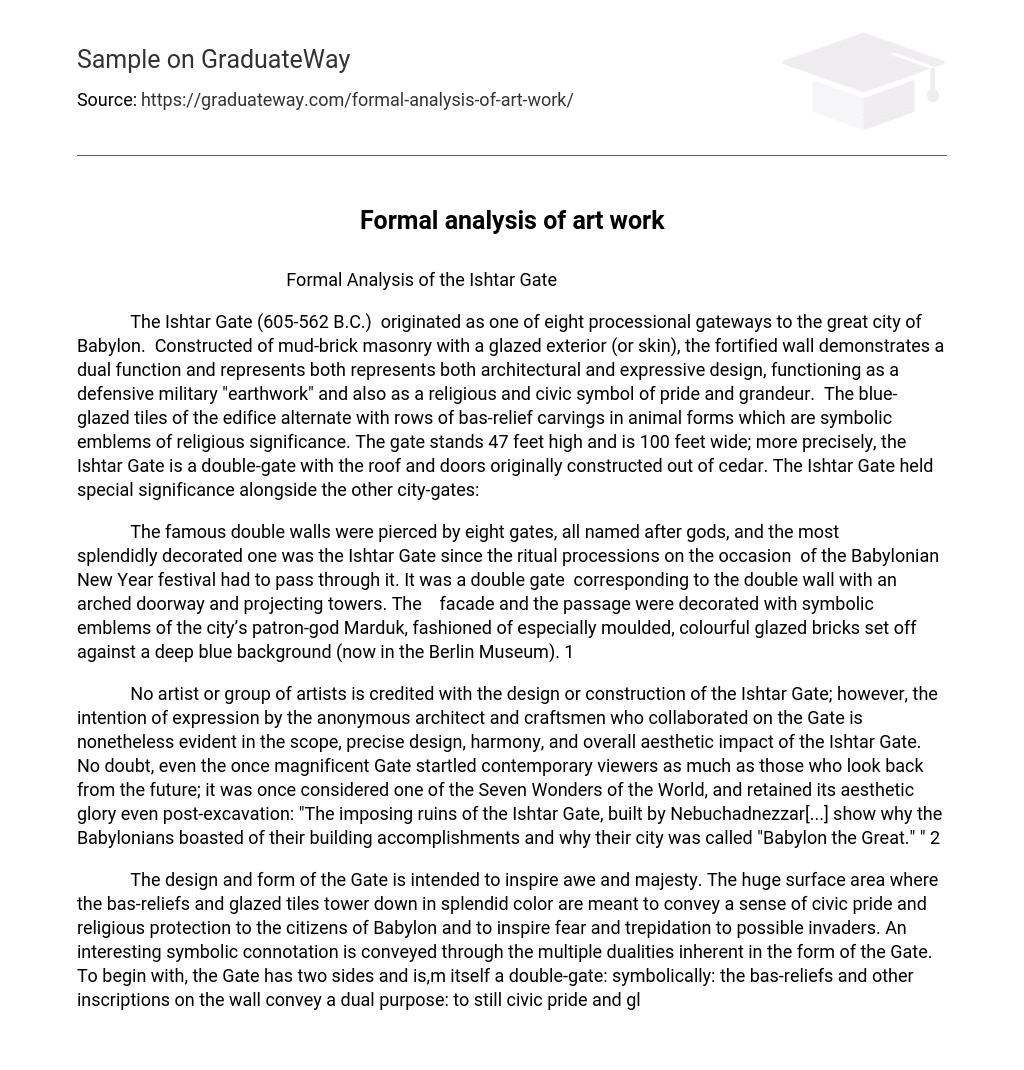The Ishtar Gate (605-562 B.C.) originated as one of eight processional gateways to the great city of Babylon. Constructed of mud-brick masonry with a glazed exterior (or skin), the fortified wall demonstrates a dual function and represents both represents both architectural and expressive design, functioning as a defensive military “earthwork” and also as a religious and civic symbol of pride and grandeur. The blue-glazed tiles of the edifice alternate with rows of bas-relief carvings in animal forms which are symbolic emblems of religious significance. The gate stands 47 feet high and is 100 feet wide; more precisely, the Ishtar Gate is a double-gate with the roof and doors. The famous double walls were pierced by eight gates, all named after gods, and the most splendidly decorated one was the Ishtar Gate since the ritual processions on the occasion of the Babylonian New Year festival had to pass through it. It was a double gate corresponding to the double wall with an arched doorway and projecting towers. The facade and the passage were decorated with symbolic emblems of the city’s patron-god Marduk, fashioned of especially moulded, colourful glazed bricks set off against a deep blue background (now in the Berlin Museum)
No artist or group of artists is credited with the design or construction of the Ishtar Gate; however, the intention of expression by the anonymous architect and craftsmen who collaborated on the Gate is nonetheless evident in the scope, precise design, harmony, and overall aesthetic impact of the Ishtar Gate. No doubt, even the once magnificent Gate startled contemporary viewers as much as those who look back from the future; it was once considered one of the Seven Wonders of the World, and retained its aesthetic glory even post-excavation: “The imposing ruins of the Ishtar Gate, built by Nebuchadnezzar[…] show why the Babylonians boasted of their building accomplishments and why their city was called “Babylon the Great.”
The design and form of the Gate is intended to inspire awe and majesty. The huge surface area where the bas-reliefs and glazed tiles tower down in splendid color are meant to convey a sense of civic pride and religious protection to the citizens of Babylon and to inspire fear and trepidation to possible invaders. An interesting symbolic connotation is conveyed through the multiple dualities inherent in the form of the Gate. To begin with, the Gate has two sides and is,m itself a double-gate: symbolically: the bas-reliefs and other inscriptions on the wall convey a dual purpose: to still civic pride and glory upon the citizens whom the wall was built to protect and to warn possible hostiles of consequences. The scope of the Gate alone — its breadth and height — is enough to suggest opulence and strong fortification; however, the Ishtar Gate — as the Grand Processional Gate, conveyed the essence of the city in a single monument. The Gate complimented and completed a huge, ” five-storied ziggurat, 20 which rose approximately 300 feet high and which some scholars have connected with the Tower of Babel described in the Old Testament in the Book of Genesis. The Ishtar Gate was erected on the processional way that led to the enclosure of the palace and ziggurat.”
In addition to its functional uses, the Gate’s design and decorative motifs offer an incisive glimpse into Babylonian aesthetics. When one considers the exceptional craftsmanship and great technical precision that went into creating the nuanced details of the Gate, it is easy to comprehend that a unity of community led to the construction of such an imposing and richly designed artifice: the splendid architecture of the Street of Processions where walls of the palaces, the gates and the bases of the battlemented walls of the processional way, with their towering buttresses at intervals, were adorned with brick reliefs enamelled in brilliant colours […] There were friezes representing pacing lions, in decorative series, while the doorways were guarded by bulls and fabulous beasts set one above another.” 4 As one of eight Gates to the fabled city of Babylon, the Ishtar Gate stood as the Crown Jewel of the city and the most singly expressive monument to Babylonian civic pride and artistic achievement.
1 Gwendolyn Leick, A Dictionary of Ancient Near Eastern Architecture (London: Routledge, 1988) 26.
2 J. A. Thompson, The Bible and Archaeology, 3rd Rev. ed. (Grand Rapids, MI: William B. Eerdmans Publishing, 1982).
3 Linnea H. Wren, and Janine M. Carter, eds., Perspectives on Western Art, vol. 1 (New York: Harper & Row, 1987) 15.
4 Frederick A. Praeger, Praeger Picture Encyclopedia of Art: A Comprehensive Survey of Painting, Sculpture, Architecture and Crafts, Their Methods, Styles and Technical Terms, from the Earliest Times to the Present Day (New York: F.A. Praeger, 1958) 113.
Works Cited
- Leick, Gwendolyn. A Dictionary of Ancient Near Eastern Architecture. London: Routledge, 1988.
- Thompson, J. A. The Bible and Archaeology. 3rd Rev. ed. Grand Rapids, MI: William B. Eerdmans Publishing, 1982.
- Praeger, Frederick A. Praeger Picture Encyclopedia of Art: A Comprehensive Survey of Painting, Sculpture, Architecture and Crafts, Their Methods, Styles and Technical Terms, from the Earliest Times to the Present Day. New York: F.A. Praeger, 1958.
- Wren, Linnea H., and Janine M. Carter, eds. Perspectives on Western Art. Vol. 1. New York: Harper & Row, 1987.





